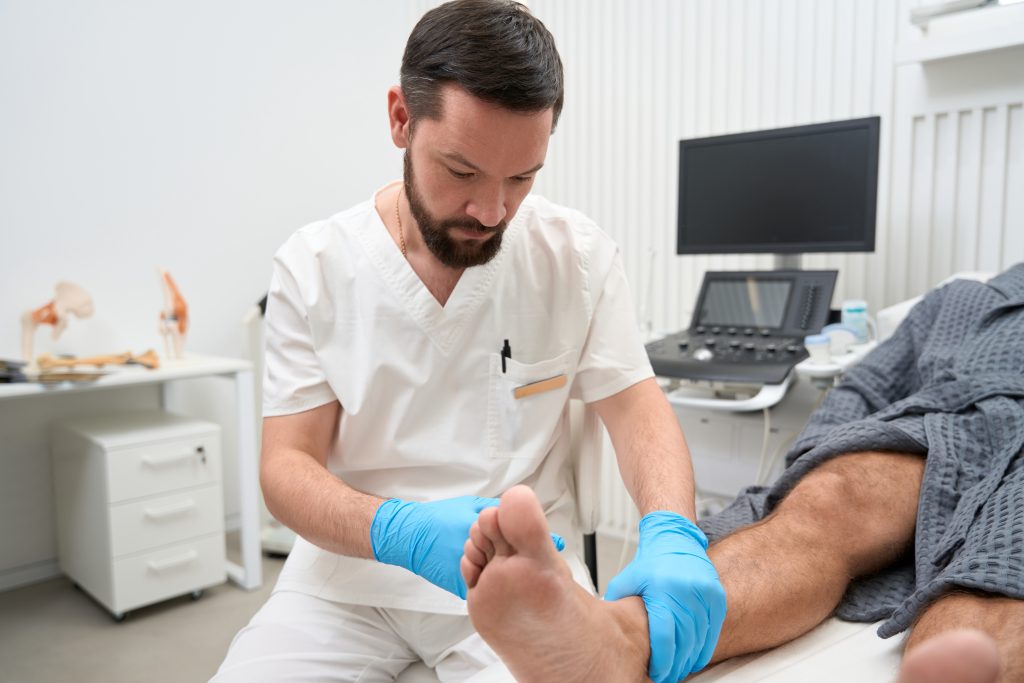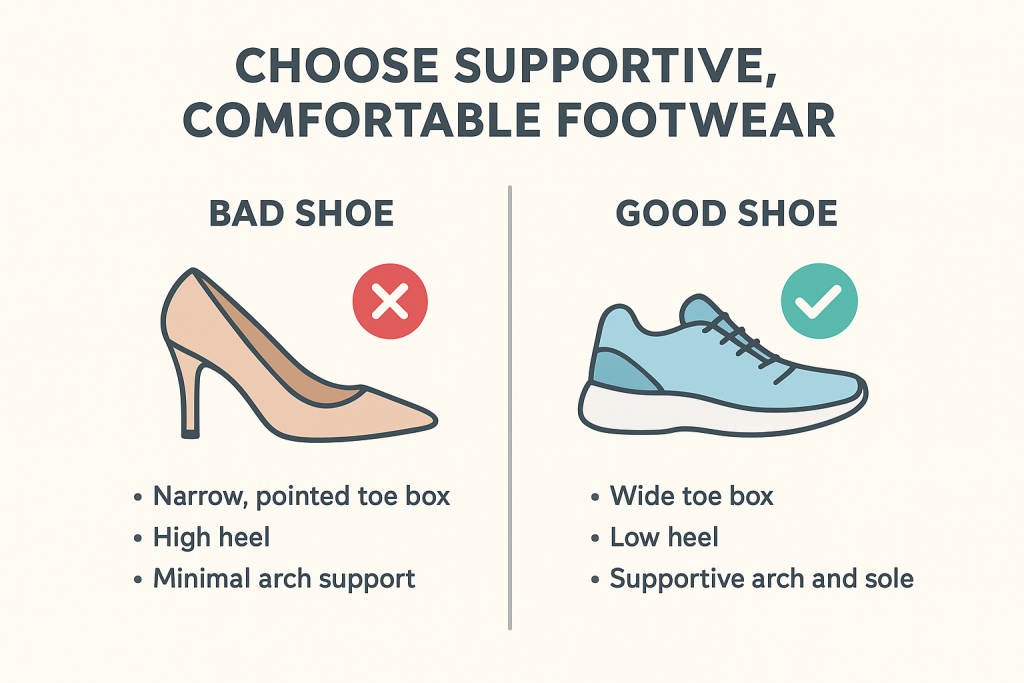
Bunions, medically known as hallux valgus, are one of the most common foot problems people face. They appear as a bony bump on the side of the big toe joint and can cause pain, swelling, and difficulty walking.
Understanding the risk factors for bunions can help you make sense of this common foot condition and, more importantly, take steps to prevent bunions in the future. We’ve broken down the data to help you understand who develops bunions and why.
Primary Risk Factors for Bunions
Gender, age, genetics, and other factors can all play a role in the development of bunions. Let’s take a look at the main risk factors and why they increase your chances of developing bunions.
| The Most Significant Risk Factors for Bunions | ||
|---|---|---|
| Risk Factor | Increased Risk | Key Details |
| Sex (Female) | 30% of women vs 13% of men | Women are at higher risk due to hormonal factors, anatomical differences, and footwear choices. |
| Age (Over 65) | 35% prevalence vs 23% under 65 | Aging weakens foot ligaments and tendons, causing joint instability and increased toe misalignment. |
| Genetic Predisposition | Moderate to high heritability (h2=0.29) | Inherited foot structure, such as metatarsal bone angles and length, impacts risk. |
| Tight Footwear | Up to 34% higher | Constricting footwear and high heels can cause chronic toe compression, leading to bunions. |
| Flat Feet/Low Arches | Moderately higher risk in adolescents | Altered foot mechanics and a lack of arch support can cause extra stress on the big toe joint, leading to bunions. |
Certain autoimmune conditions, like rheumatoid arthritis, have also been linked with an increased risk of bunions in some studies, but there is conflicting evidence on this topic. Similarly, weight (specifically a high BMI) may be a risk factor, but more data is needed to confirm this link.
High-Risk Occupations and Activities
As well as the risk factors we’ve already talked about, certain professions and activities put additional stress on your feet, increasing your risk of developing bunions. If you’re working in these fields or participating in these activities, here’s why you’re more likely to develop bunions, and what you can do about this increased risk:
| Activities and Occupations that Increase Bunion Risk | ||
|---|---|---|
| Occupation/Activity | Primary Stress Factor | Prevention Strategy |
| Ballet/Dance | Repeated toe pressure | Proper training shoes |
| Nursing | Long periods on feet | Supportive work shoes |
| Retail/Service | Extended walking/standing | Regular breaks, orthotics |
| Running | Repetitive impact | Proper running shoes |
| Construction | Heavy boots, uneven surfaces | Steel toe alternatives |
How to Reduce Your Bunion Risk
While you can’t change certain risk factors for bunions, like your genetics, age, or natural foot shape, there are proactive steps you can take to lower your risk and slow the progression of bunions if they’re already forming. Here are the most effective ways to care for your feet and reduce bunion risk.
Schedule Regular Foot Check-Ups
Just as you see a dentist for preventive care, consider checking in with a podiatrist, especially if:
- Bunions run in your family
- You have flat feet, high arches, or another structural risk factor
- You spend long hours standing or walking for work
Early detection makes a difference. A podiatrist can spot subtle changes in your toe joint alignment and recommend preventive strategies before the bunion worsens, such as orthotics, stretches, or footwear modifications.
Choose Supportive, Comfortable Footwear
Shoes are one of the most significant modifiable risk factors for bunions. Proper footwear can dramatically reduce stress on your big toe joint. Look for shoes that are:
- Wide in the toe box so your toes aren’t squeezed together
- Low-heeled, ideally less than two inches to prevent excess forward pressure
- Supportive in the arch and sole to help distribute weight evenly

Avoid narrow, pointed, or high-heeled shoes for daily wear. If you love heels, save them for short periods and choose styles with more stability, such as block heels instead of stilettos.
Use Orthotics for Flat Feet or High Arches
If you have flat feet, high arches, or other structural issues that increase your bunion risk, custom orthotics prescribed by a podiatrist can make a big difference.
Orthotics help by:
- Improving foot alignment
- Reducing excess inward rolling (overpronation) or outward rolling (supination)
- Distributing weight more evenly across the foot
While over-the-counter orthotic insoles can offer some support, custom options are best if you already notice discomfort or you have other bunion risk factors.
Maintain a Healthy Body Weight
Carrying extra weight adds pressure to your feet and accelerates joint misalignment. Maintaining a healthy BMI can ease the load on your big toe joint, reduce inflammation, and slow bunion progression. Pairing supportive footwear with weight management is even more important if you’re already prone to bunions.
Strengthen and Stretch Your Feet
Just like other muscles and joints in your body, your feet benefit from regular exercise. Gentle stretches and strengthening exercises may help keep your toes aligned and joints flexible. Try:
- Toe spreads: Spread your toes apart and hold for a few seconds, repeating several times.
- Towel scrunches: Use your toes to scrunch a towel on the floor.
- Toe circles: Rotate each big toe gently to maintain mobility.
- Calf and arch stretches: Relieve tightness that can pull on the toe joint.
These exercises don’t “cure” bunions, but they can keep your feet stronger and more resilient.
Use Protective Pads or Toe Spacers
If you notice early signs of bunions, like a slight bump, redness, or discomfort, using toe spacers or bunion pads can reduce friction and help keep your big toe in better alignment. These are especially useful if your lifestyle or job requires long hours on your feet.
Manage Underlying Medical Conditions
If you have conditions like rheumatoid arthritis or connective tissue disorders, working with your doctor to keep inflammation under control can help protect your feet. Learn more about your triggers and what causes flare-ups, whether it’s stress, certain foods, or other factors.
Take Control of Your Foot Health With Geldwert Bunion Center
Understanding your risk factors for bunions is the first step toward preventing them. While you can’t change your genes or completely eliminate all risk factors, you can make choices that reduce your risk of developing bunions, like wearing comfortable shoes, maintaining a healthy weight, and exercising your feet.
If you do develop a bunion, seek treatment. Early intervention can reduce your recovery time and save you months or even years of discomfort. At Geldwert Bunion Center, we specialize in a revolutionary, minimally invasive correction method using the HyperFlex medical device. While traditional bunion surgery can leave you in a walking boot for months, many of our patients are able to walk out of the clinic in a comfortable pair of sneakers.
If you need corrective bunion surgery, contact our office to set up a consultation.